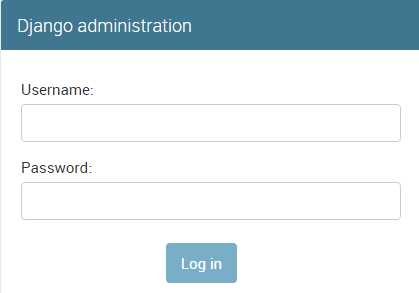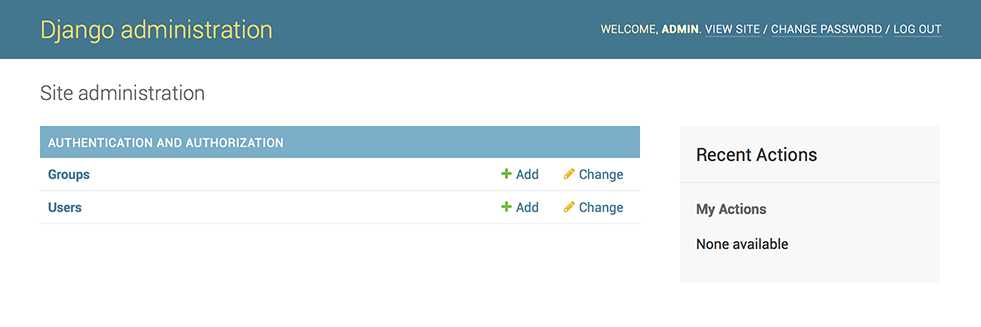标签:elf timezone engine 技术分享 程序 style join site from
Django默认使用的是SQLite这一轻量的数据库
如果需要配置别的数据库需要修改setting.py文件
默认配置为
DATABASES = {
‘default‘: {
‘ENGINE‘: ‘django.db.backends.sqlite3‘,
‘NAME‘: os.path.join(BASE_DIR, ‘db.sqlite3‘),
}
}
可以修改为
DATABASES = {
‘default‘: {
‘ENGINE‘: ‘django.db.backends.postgresql‘,
‘NAME‘: ‘mydatabase‘,
‘USER‘: ‘mydatabaseuser‘,
‘PASSWORD‘: ‘mypassword‘,
‘HOST‘: ‘127.0.0.1‘,
‘PORT‘: ‘5432‘,
}
}
其中参数说明为
ENGINE:
‘django.db.backends.sqlite3‘,
‘django.db.backends.postgresql‘,
‘django.db.backends.mysql‘,
‘django.db.backends.oracle‘
NAME:数据库的名称
如果使用SQLite,数据库将是您计算机上的一个文件, 此时NAME 应该是该文件的完全绝对路径,包括文件名。
默认值,将文件存储在项目目录中。os.path.join(BASE_DIR, ‘db.sqlite3‘)
除此之外, setting.py还需要配置
TIME_ZONE 为当前时区
INSTALLED_APPS 包含当前需要使用的所有应用程序, 如果新建的应用程序, 应该添加上
默认的值有
django.contrib.admin - 管理网站
django.contrib.auth - 认证系统
django.contrib.contenttypes - 内容类型的框架
django.contrib.sessions - 会话框架
django.contrib.messages - 消息框架
django.contrib.staticfiles - 一个用于管理静态文件的框架
执行命令在数据库中创建表
python manage.py migrate
- 该命令会查看INSTALLED_APPS 的设置
- 还根据mysite/settings.py中的数据库设置来创建数据库表
Django遵循Don’t repeat yourself (DRY)原则, 使得在一个地方定义数据模型, 并自动获取数据
具体创建如下
polls/models.py
from django.db import models
class Question(models.Model):
question_text = models.CharField(max_length=200)
pub_date = models.DateTimeField(‘date published‘)
class Choice(models.Model):
question = models.ForeignKey(Question, on_delete=models.CASCADE)
choice_text = models.CharField(max_length=200)
votes = models.IntegerField(default=0)
一个模型就是一个类, 这个类继承自 django.db.models.Model
每个模型有类变量, 每个类变量相当于一个数据库字段
这个字段用 Field 类的实例表示
AutoField: 是整形类型的数据, 用作ID递增, 具有自增的效果, 默认会自动添加一个该字段
BigAutoField: 64位整数的自动递增ID, 范围从1到9223372036854775807
BigIntegerField: 64位整数, 范围-9223372036854775808到 9223372036854775807
BinaryField: 二进制数据字段, 官方不推荐使用
BooleanField: 布尔值. 当Field.default 没有定义时默认值为None
如果需要可以设置为null, 可以使用NullBooleanField
CharField: 字符串类型
必须传入max_length设置最大长度
DateField: 日期类型, 值是datetime.date对象
auto_now: True/False, 表示每次保存时设置为当前时间, 也就是最后修改时间
auto_now_add: True/False, 表示首次创建时设置为当前时间, 也就是创建时间
DateTimeField: 日期类型, 值是datetime.datetime对象
TimeField:日期类型, 值是datetime.time对象
DecimalField: 固定精度的十进制数, 值是Decimal值
必须参数max_digits: 最大位数
必须参数decimal_places: 小数位数
DurationField: 时间段, 值是timedelta
EmailField: 邮箱类型
FileField: 文件上传字段
FilePathField
FloatField: 浮点数类型, 值为float类型
ImageField
IntegerField: 整数类型, 取值范围为-2147483648到2147483647
PositiveIntegerField: 正整数类型, 取值范围为0到2147483647
SmallIntegerField: 较短的整数, 取值范围为0到32767
PositiveSmallIntegerField: 较短的正整数, 取值范围为-32768到32767
GenericIPAddressField: IP地址(IPv4和IPv6都可以), 以字符串形式
TextField: 文本类型
SlugField: 类似CharField, 常用于URL
URLField
UUIDField
其中ForeignKey表示外键引入
根据已经创建好的模型, 就可以其创建数据库表, 并通过API进行数据操作
(1) 首先需要修改INSTALLED_APPS
前面也说过, Django的应用支持即插即用的特性, 因此刚才创建的model所在的应用需要添加到INSTALLED_APPS中
mysite/settings.py
INSTALLED_APPS = [
‘polls.apps.PollsConfig‘,
‘django.contrib.admin‘,
‘django.contrib.auth‘,
‘django.contrib.contenttypes‘,
‘django.contrib.sessions‘,
‘django.contrib.messages‘,
‘django.contrib.staticfiles‘,
]
(2) 告诉Django对应用pools做了更改, 进而生成更改信息
python manage.py makemigrations polls
然后会得到结果
Migrations for ‘polls‘:
polls/migrations/0001_initial.py:
- Create model Choice
- Create model Question
- Add field question to choice
此时可以查看如果迁移的话会执行什么SQL语句
python manage.py sqlmigrate polls 0001
结果为
BEGIN;
--
-- Create model Choice
--
CREATE TABLE "polls_choice" (
"id" serial NOT NULL PRIMARY KEY,
"choice_text" varchar(200) NOT NULL,
"votes" integer NOT NULL
);
--
-- Create model Question
--
CREATE TABLE "polls_question" (
"id" serial NOT NULL PRIMARY KEY,
"question_text" varchar(200) NOT NULL,
"pub_date" timestamp with time zone NOT NULL
);
--
-- Add field question to choice
--
ALTER TABLE "polls_choice" ADD COLUMN "question_id" integer NOT NULL;
ALTER TABLE "polls_choice" ALTER COLUMN "question_id" DROP DEFAULT;
CREATE INDEX "polls_choice_7aa0f6ee" ON "polls_choice" ("question_id");
ALTER TABLE "polls_choice"
ADD CONSTRAINT "polls_choice_question_id_246c99a640fbbd72_fk_polls_question_id"
FOREIGN KEY ("question_id")
REFERENCES "polls_question" ("id")
DEFERRABLE INITIALLY DEFERRED;
COMMIT;
可以看到:
1) 表名是小写的
2) 主键ID会自动添加
3) 外键在表中的名字是 外键字段+"_id"
此时还可以进行数据库的检查
python manage.py check
(3) 创建数据库表
python manage.py migrate
这条命令会使得makemigrations生成的更改信息生效, 也就是对数据库进行修改或新增表等操作
总结:
迁移这条命令功能很强大
但现目前只需要执行这三天基础操作:配置INSTALLED_APPS, makemigrations和migrate
进入manage的shell
python manage.py shell
具体执行代码
# 导入
>>> from polls.models import Question, Choice
# questions的内容信息
>>> Question.objects.all()
<QuerySet []>
# 创建一条记录并保存
# 使用timezone.now()代替datetime.datetime.now()
>>> from django.utils import timezone
>>> q = Question(question_text="What‘s new?", pub_date=timezone.now())
>>> q.save()
# 查看属性值
>>> q.id
1
>>> q.question_text
"What‘s new?"
>>> q.pub_date
datetime.datetime(2017, 6, 25, 4, 1, 46, 582600, tzinfo=<UTC>)
# 修改属性值并保存
>>> q.question_text = "what is your name?"
>>> q.save()
# questions的内容信息
>>> Question.objects.all()
<QuerySet [<Question: Question object>]>
显然最后我们得到的<QuerySet [<Question: Question object>]>并不友好, 不能看到确切的内容
因此可以修改一下模型内容为
polls/models.py
import datetime
from django.db import models
from django.utils.encoding import python_2_unicode_compatible
from django.utils import timezone
# 如果要使得__str__能够在python2生效就使用该装饰器
@python_2_unicode_compatible
class Question(models.Model):
question_text = models.CharField(max_length=200)
pub_date = models.DateTimeField(‘date published‘)
def __str__(self):
return self.question_text
def was_published_recently(self):
return self.pub_date >= timezone.now() - datetime.timedelta(days=1)
@python_2_unicode_compatible
class Choice(models.Model):
question = models.ForeignKey(Question, on_delete=models.CASCADE)
choice_text = models.CharField(max_length=200)
votes = models.IntegerField(default=0)
def __str__(self):
return self.choice_text
加入__str__()方法之后, 不仅可以使得在shell中输出会有更加确切的信息, 还会使得在后台管理的时候也会有效果
同时在太Question中加入一个测试是否是最近一天发布的函数
# 导入
>>> from polls.models import Question, Choice
# 查询question, 此时可以看到显示和之前不一样了
>>> Question.objects.all()
<QuerySet [<Question: what is your name?>]>
# 使用filter()可以过滤查找id为1的数据
>>> Question.objects.filter(id=1)
<QuerySet [<Question: what is your name?>]>
# 使用__startwith
>>> Question.objects.filter(question_text__startswith = ‘what‘)
<QuerySet [<Question: what is your name?>]>
# 判断该question是否是今年发布
# 使用__year
>>> from django.utils import timezone
>>> current_year = timezone.now().year
>>> Question.objects.get(pub_date__year=current_year)
<Question: what is your name?
# 用pk(primary key的缩写)查询主键为1的question
# 相当于 Question.objects.get(id=1)
>>> Question.objects.get(pk=1)
<Question: what is your name?>
# 测试一下刚才的函数
>>> q = Question.objects.get(pk=1)
>>> q.was_published_recently()
True
# 使用 引用该表作为外键的表名_set 来获取对应的外键信息(反向操作)
>>> q = Question.objects.get(pk=1)
>>> q.choice_set.all()
<QuerySet []>
# 反向操作创建
>>> q.choice_set.create(choice_text=‘Not much‘, votes=0)
<Choice: Not much>
>>> q.choice_set.create(choice_text=‘The sky‘, votes=0)
<Choice: The sky>
>>> c = q.choice_set.create(choice_text=‘Just hacking again‘, votes=0)
>>> c
<Choice: Just hacking again>
# 得到的choice可以正向查看question
>>> c.question
<Question: what is your name?>
# _set的操作
>>> q.choice_set.all()
<QuerySet [<Choice: Not much>, <Choice: The sky>, <Choice: Just hacking again>]>
>>> q.choice_set.count()
3
>>> q.choice_set.filter(choice_text__startswith=‘Just‘)
<QuerySet [<Choice: Just hacking again>]>
# 正向操作relationship
# 使用双下划线来分割关系, 可以递进多层都没有关系, 只要你想
>>> Choice.objects.filter(question__pub_date__year=current_year)
<QuerySet [<Choice: Not much>, <Choice: The sky>, <Choice: Just hacking again>]>
# 删除一波数据
>>> c = q.choice_set.get(pk=3)
>>> c
<Choice: Just hacking again>
>>> c.delete()
(1, {‘TestModel.Choice‘: 1})
>>> q.choice_set.count()
2
更多信息:
1) 创建管理员
python manage.py createsuperuser
进而输入用户名, 邮箱, 密码(有复杂性要求, 测试的时候贼烦(*`皿´*)?)
2) 启动服务器
python manage.py runserver
登录后台
http://127.0.0.1:8000/admin

后台系统为

3) 可以看到, 没有我们新建的应用, 此时需要手动将应用添加到系统管理
polls/admin.py
from django.contrib import admin
from .models import Question
admin.site.register(Question)

进而可以对其进行一系列操作了


如下是历史记录

标签:elf timezone engine 技术分享 程序 style join site from
原文地址:http://www.cnblogs.com/weihuchao/p/7076570.html